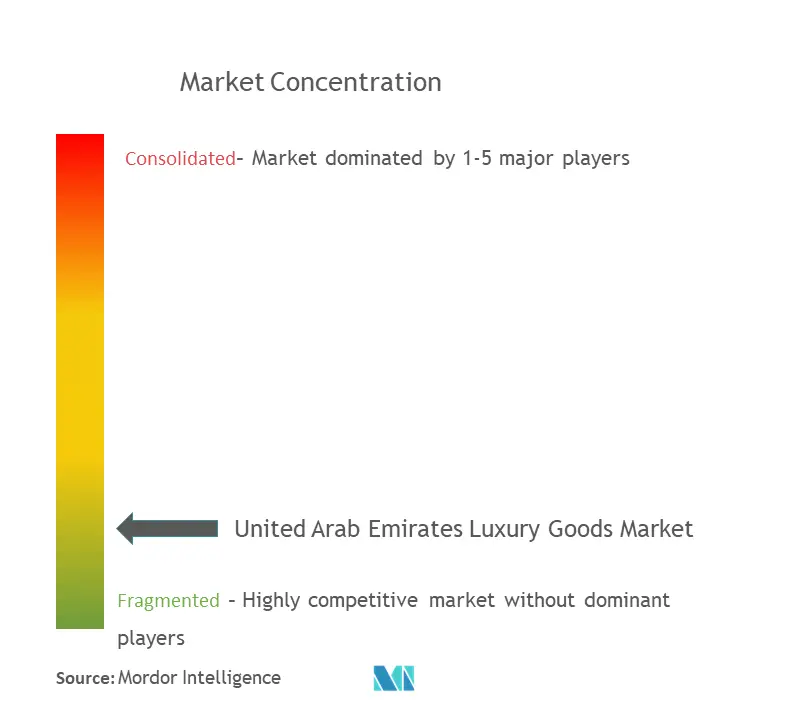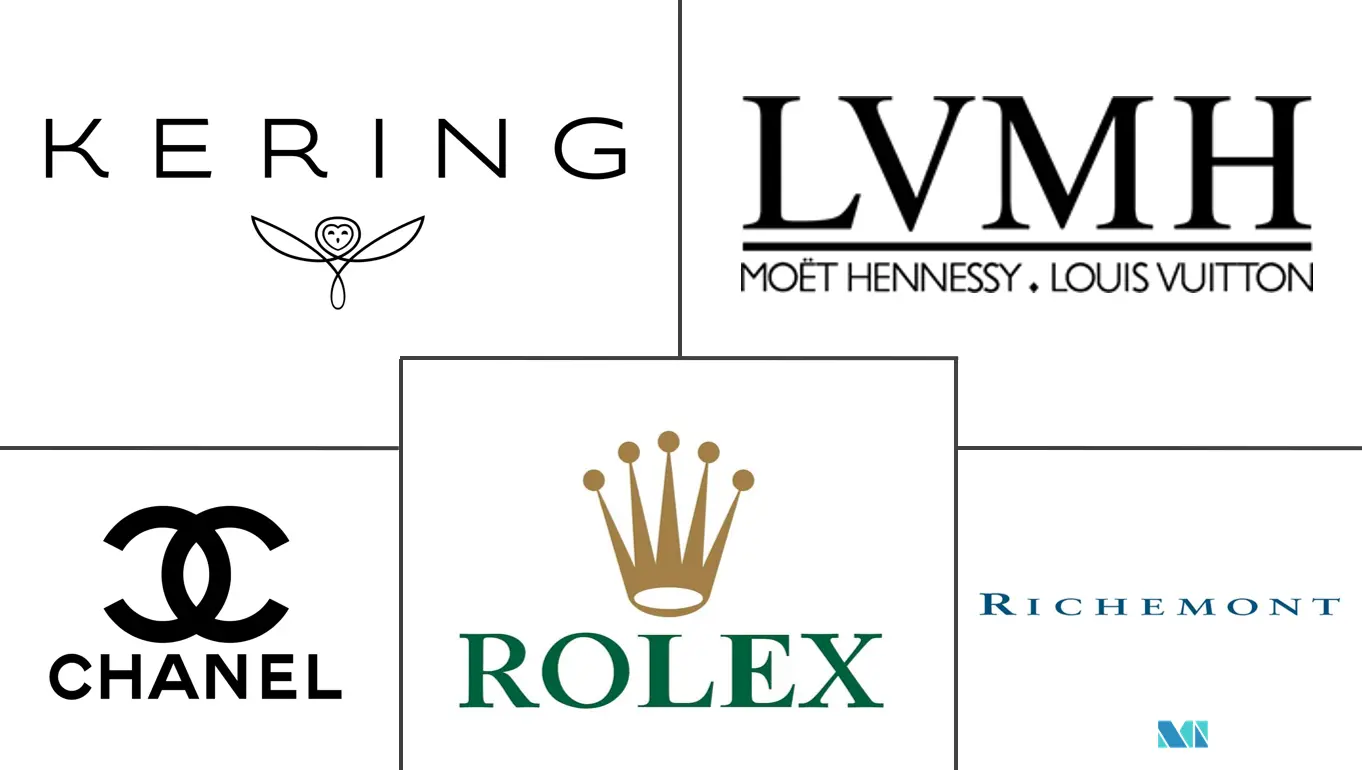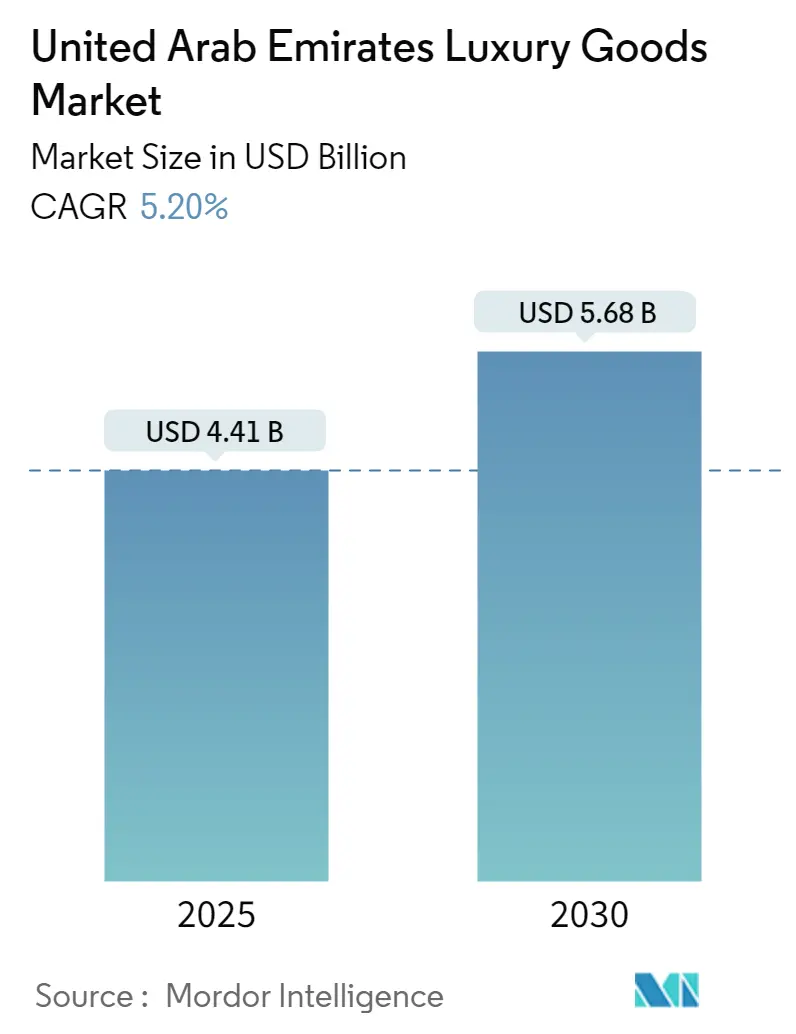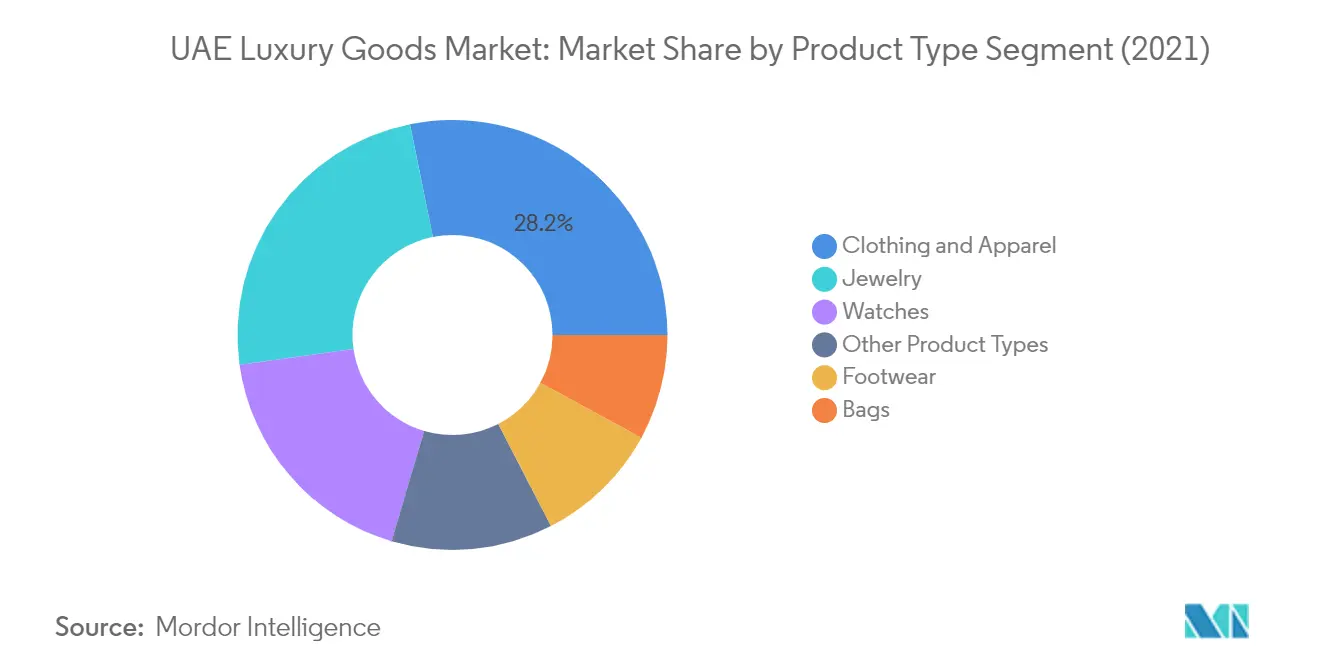UAE Luxury Goods Market Analysis
The United Arab Emirates Luxury Goods Market size is estimated at USD 4.41 billion in 2025, and is expected to reach USD 5.68 billion by 2030, at a CAGR of 5.2% during the forecast period (2025-2030).
The United Arab Emirates continues to strengthen its position as a global luxury lifestyle hub, supported by robust economic fundamentals and increasing consumer affluence. The country's projected GDP per capita growth from USD 50,254 in 2024 to USD 51,196 in 2025 reflects the strong purchasing power of its population. The luxury market benefits from the country's high urbanization rate of 87.05%, which has created concentrated wealth centers in Dubai and Abu Dhabi. The nation's economic stability, coupled with its status as a tax-friendly jurisdiction for individuals, has established it as an attractive destination for luxury retail expansion.
The digital transformation of luxury retail has accelerated significantly, with e-commerce sales reaching USD 27.08 billion in 2022. Luxury brands are increasingly adopting sophisticated omnichannel strategies to enhance customer experience. The market has witnessed a notable shift toward digital innovation, with brands implementing advanced technologies such as 3D product visualization, virtual try-ons, and AI-powered personalization. The country's 100% internet penetration rate has created an ideal environment for luxury brands to experiment with innovative digital solutions while maintaining their premium positioning.
Sustainability and ethical luxury have emerged as crucial differentiators in the UAE's luxury goods market. The launch of sustainable collections, such as Orchard Moon's eco-friendly abayas made from plant-based and vegan fabrics, demonstrates the market's evolution toward conscious luxury. Multi-brand retailers are expanding their eco-friendly product offerings, with platforms like The Luxury Closet curating sustainable collections from premium brands including Hermes, Stella McCartney, and Citizen. This shift reflects a growing awareness among UAE consumers about environmental impact and ethical production practices.
The luxury market is witnessing a significant transformation in consumer behavior, with personalization becoming increasingly important. Luxury retailers are leveraging data analytics and artificial intelligence to provide tailored shopping experiences and product recommendations. The trend toward limited edition and exclusive products has gained momentum, particularly in categories such as watches and jewelry. Premium retailers are responding by creating unique experiences, such as invitation-only shopping events and personalized styling services, to cater to the evolving preferences of sophisticated consumers who seek exclusivity and individualized attention in their personal luxury goods.
UAE Luxury Goods Market Trends
Growing Affluent Population in the Country
The United Arab Emirates maintains its position as one of the wealthiest nations globally, with its economic strength primarily derived from diverse sectors including petroleum, petrochemicals, aluminum, and cement industries. The country's robust legal and security framework, coupled with substantial financial reserves and sovereign wealth funds, has created an environment that continues to attract high-net-worth individuals (HNWIs) from around the world. The nation's tax-friendly policies, particularly the zero personal income tax on employment, real estate, and equity investments, have made it an increasingly attractive destination for wealthy investors and professionals.
The country's strategic approach to attracting affluent individuals is further evidenced by its innovative visa policies and banking initiatives. The implementation of the 10-year "Golden Visa" program, combined with attractive financial incentives from major banks like Abu Dhabi Commercial Bank and First Abu Dhabi Bank, has successfully drawn wealthy individuals and highly skilled professionals to the region. These banks offer specialized benefits such as reduced mortgage fixed-interest rates for real estate Golden Visa investors and preferential rates on savings accounts for non-real estate investors, creating a comprehensive ecosystem that caters to the affluent population's financial needs.
Emergence of E-Commerce
The digital transformation of the UAE's luxury retail landscape has revolutionized the traditional purchasing journey, creating new opportunities for both single and multi-brand luxury stores. The sophisticated digital ecosystem provides consumers with unprecedented access to product information, pricing transparency, and seamless shopping experiences. Leading luxury brands have embraced this digital evolution through various initiatives, including partnerships with multi-brand platforms like Farfetch, development of proprietary e-commerce websites, and implementation of innovative digital solutions. The integration of advanced technologies such as augmented reality (AR) and metaverse capabilities has significantly enhanced the online shopping experience for luxury consumers.
The government's proactive approach in promoting e-commerce has been instrumental in driving market growth, exemplified by the establishment of Matajircom, a duty-free e-commerce hub designed to facilitate collaboration between local and international companies. Recent market developments include the entry of Business of Preloved Fashion (BOPF) in April 2022, which launched an online platform to create direct buyer-seller interactions in the luxury fashion segment. The evolution of logistics capabilities, faster delivery services, and hassle-free return policies has further strengthened consumer confidence in online luxury items purchases, contributing to the sector's digital transformation.
Increasing Tourism and Growing Cultural Influence
The United Arab Emirates has established itself as a premier global tourism destination, with Dubai's Department of Economy and Tourism reporting over 7 million international visitors during the first half of 2022, marking a substantial 183% year-over-year increase. This robust tourism growth directly correlates with the expansion of the luxury goods market, as international visitors often possess high disposable incomes and demonstrate a strong propensity to purchase luxury accessories during their stays. The country's strategic position as an early launch market for premium products from multinational brands has further enhanced its appeal to luxury-seeking tourists.
The cultural influence in the GCC region, particularly in the UAE, plays a pivotal role in driving luxury consumption patterns. The country's strong family-oriented culture and the tradition of gift-giving, especially during festivities like Ramadan and Eid, create consistent demand for luxury products. This cultural aspect is evidenced by the diverse product offerings from luxury brands, such as Gucci's extensive portfolio of 29 luxury perfume variants specifically curated for the UAE market. The combination of cultural preferences and high average incomes has created a unique market environment where consumers readily invest in luxury goods to maintain social status and uphold cultural traditions.
Powerful Strategies Influence the Market
Luxury brands in the UAE market have adopted sophisticated strategies to enhance both online and in-store shopping experiences. Premium fashion houses are investing heavily in innovative retail concepts and digital integration to create immersive shopping experiences. For instance, IWC Schaffhausen has revolutionized the traditional retail model by implementing a 360-degree virtual replica system in its flagship boutiques, enabling customers to seamlessly transition between physical and digital shopping experiences. This strategic approach to retail innovation has helped brands maintain their premium positioning while adapting to evolving consumer preferences.
The market has witnessed a significant trend toward modest wear, with luxury brands developing specialized collections to cater to the region's cultural preferences. This strategic adaptation has created a lucrative market segment, with brands focusing on designs that address both spiritual and stylistic requirements. Multi-brand luxury retailers and resellers have also strengthened their market position through strategic investments and partnerships. The success of these strategies is evident in the growing number of luxury brand boutiques across premium shopping destinations in Dubai and Abu Dhabi, where retailers continue to introduce innovative concepts and exclusive collections tailored to local preferences and international tourism demand. The rise of affordable luxury options has also allowed a broader audience to access high-end products, further diversifying the market.
Segment Analysis: Product Type
Clothing and Apparel Segment in UAE Luxury Goods Market
The luxury apparel segment continues to dominate the United Arab Emirates luxury goods market, commanding approximately 28% market share in 2024. This segment's strong performance can be attributed to the UAE's position as one of the world's most popular shopping destinations and its robust presence in the global fashion industry. The abundance of skilled labor, constructive government policies, and the use of cutting-edge technologies have made the UAE a feasible center for luxury textiles and clothing. The country's status as a major tourist destination has further bolstered the segment's growth, with visitors often making significant purchases from various multinational brand outlets. Additionally, the shift in consumer preferences towards greater value and transparency has prompted retail giants to strengthen their positions through strategic partnerships with designers and social media channels.
Watches Segment in UAE Luxury Goods Market
The luxury watch segment is emerging as the fastest-growing category in the UAE luxury goods market, projected to grow at approximately 6% CAGR from 2024 to 2029. This remarkable growth is driven by the increasing affluent population and their voracious appetite for luxury watches. The segment's growth is particularly notable in Dubai, where residents and visitors alike demonstrate a strong preference for globally recognized watch brands. The market has seen significant traction in ultra-exclusive timepieces, special editions, and bespoke watches, catering to the sophisticated tastes of local consumers. Swiss watch manufacturers have particularly benefited from this trend, introducing various timepieces featuring symbolic depictions of the region, from desert-inspired color combinations to metiers d'arts depictions of Arabian wildlife, resonating strongly with the local culture and heritage.
Remaining Segments in Product Type
The UAE luxury goods market encompasses several other significant segments, including luxury jewelry, luxury handbags, and luxury footwear, each contributing uniquely to the market's dynamics. The luxury jewelry segment maintains a strong presence, particularly driven by tourist purchases and residents' preferences for new designs. The luxury handbag segment has evolved with changing consumer preferences, with luxury brands offering various styles from traditional to contemporary designs. The luxury footwear segment has shown steady growth, particularly influenced by the rising demand for luxury sneakers and designer shoes. These segments collectively reflect the diverse preferences of UAE consumers, ranging from traditional luxury items to contemporary fashion statements, while maintaining their appeal to both local residents and international visitors.
Segment Analysis: Distribution Channel
Offline Channels Segment in UAE Luxury Goods Market
The offline channels segment continues to dominate the United Arab Emirates luxury goods market, commanding approximately 88% of the total market share in 2024. This substantial market presence is primarily attributed to the segment's ability to provide an immersive and personalized shopping experience that luxury consumers highly value. Multi-brand stores account for the majority of luxury goods sales, including clothing, footwear, watches, and other accessories, due to their extensive market space catering to diverse consumer preferences. The segment's strength is further reinforced by the presence of prestigious shopping destinations like The Dubai Mall, Mall of the Emirates, and the Marina Mall, which house numerous luxury brand boutiques and provide an opulent shopping environment. Single-brand retailers have also contributed significantly to the segment's dominance by offering exclusive product lines and maintaining direct control over the customer experience and brand presentation.
Online Channels Segment in UAE Luxury Goods Market
The online channels segment is projected to experience the highest growth rate in the UAE luxury goods market, with an expected CAGR of approximately 6% during the forecast period 2024-2029. This accelerated growth is driven by several factors, including the increasing adoption of e-commerce platforms by luxury brands and the growing comfort level of affluent consumers with online shopping. The segment's expansion is supported by significant improvements in logistics capabilities, faster delivery services, and hassle-free return policies implemented by luxury retailers. Multi-brand online platforms and brand-specific e-commerce websites have been enhancing their digital capabilities by incorporating advanced features such as virtual try-ons, 360-degree product views, and personalized shopping experiences. The convenience of 24/7 shopping accessibility, coupled with the availability of exclusive online collections and competitive pricing, has been instrumental in driving the segment's growth trajectory.
UAE Luxury Goods Industry Overview
Top Companies in United Arab Emirates Luxury Goods Market
The luxury goods market in the UAE is characterized by intense product innovation and strategic expansion initiatives from leading players. Companies are focusing on developing innovative product ranges to meet evolving consumer preferences, particularly in luxury fashion accessories segments. Operational agility is demonstrated through multi-channel distribution strategies encompassing perfumeries, direct-to-consumer websites, department stores, and e-retailers to expand prestige brand offerings. Strategic moves include extensive investments in brand promotion, partnerships with local distributors, and expansion of distribution networks to gain competitive advantages. Companies are also emphasizing robust investments in digital transformation, launching e-commerce platforms, and enhancing omnichannel experiences. The market has witnessed significant product launches in categories like jewelry, watches, fragrances, and fashion, with companies increasingly tailoring their offerings to local preferences and cultural requirements.
Global Conglomerates Dominate UAE Luxury Market
The UAE luxury goods market is predominantly controlled by established global conglomerates with diverse brand portfolios, including Richemont SA, Rolex SA, LVMH, and Kering SA. These companies leverage their international presence and strong brand equity to maintain market leadership, while also partnering with local distributors like Chalhoub Group to enhance market penetration. The market structure is characterized by high barriers to entry due to brand recognition requirements, substantial capital investments, and the need for established distribution networks.
The market demonstrates a moderate level of consolidation, with major players continuously strengthening their positions through strategic acquisitions and partnerships. Merger and acquisition activities have been notable, with companies like LVMH acquiring Tiffany & Co. and Roberto Cavalli being acquired by Damac Properties Dubai, indicating the market's attractiveness for strategic investments. Local partnerships and joint ventures have become increasingly important for international brands to establish and expand their presence in the UAE market, particularly in luxury retail and distribution channels.
Innovation and Localization Drive Market Success
Success in the UAE luxury brands market increasingly depends on companies' ability to balance global brand prestige with local market understanding. Incumbent players are focusing on developing innovative product lines that cater to local preferences while maintaining their international brand identity. Digital transformation and omnichannel presence have become crucial, with companies investing in e-commerce platforms and digital marketing initiatives. The ability to offer personalized experiences, both online and offline, while maintaining exclusive brand positioning, has become a key differentiator for market leaders.
For contenders looking to gain market share, understanding local consumer behavior and cultural nuances is paramount. Companies need to develop strong relationships with local partners and invest in building brand awareness through targeted marketing campaigns. The market presents moderate substitution risks, primarily from counterfeit products and emerging local luxury brands. Regulatory compliance, particularly regarding sustainability and ethical sourcing, is becoming increasingly important for maintaining market position. Success also depends on companies' ability to adapt to changing consumer preferences, especially regarding sustainable and ethical luxury products, while maintaining premium positioning and exclusivity.
UAE Luxury Goods Market Leaders
-
Rolex SA
-
Kering Group
-
Chanel SA
-
LVMH Moët Hennessy Louis Vuitton
-
Compagnie Financière Richemont S.A.
- *Disclaimer: Major Players sorted in no particular order

UAE Luxury Goods Market News
- March 2022: Kering Group's Gucci debuted its glittering high jewelry pieces encompassing necklaces, rings, and bracelets in the United Arab Emirates. The jewelry pieces are created using white gold, white diamonds, and sapphires in many hues.
- July 2021: Versace unveiled its new boutique at The Galleria Al Maryah Island, Abu Dhabi. The new boutique spans 152 square meters and features a full selection of Versace ready-to-wear fashion and accessories for men and women.
- May 2021: A new Rolex Boutique was opened at The Galleria Al Maryah Island in Abu Dhabi, the capital of the United Arab Emirates. The boutique features a "watchbar" and various seating areas where clients are welcome to sit, as well as a VIP room that proudly displays the extensive collection.
UAE Luxury Goods Market Report - Table of Contents
1. INTRODUCTION
- 1.1 Study Assumptions and Market Definition
- 1.2 Scope of the Study
2. RESEARCH METHODOLOGY
3. EXECUTIVE SUMMARY
4. MARKET DYNAMICS
- 4.1 Market Drivers
- 4.2 Market Restraints
-
4.3 Porter's Five Forces Analysis
- 4.3.1 Threat of New Entrants
- 4.3.2 Bargaining Power of Buyers/Consumers
- 4.3.3 Bargaining Power of Suppliers
- 4.3.4 Threat of Substitute Products
- 4.3.5 Intensity of Competitive Rivalry
5. MARKET SEGMENTATION
-
5.1 By Product Type
- 5.1.1 Clothing and Apparel
- 5.1.2 Footwear
- 5.1.3 Bags
- 5.1.4 Jewelry
- 5.1.5 Watches
- 5.1.6 Other Product Types
-
5.2 By Distribution Channel
- 5.2.1 Offline Retail Channels
- 5.2.2 Online Retail Channels
6. COMPETITIVE LANDSCAPE
- 6.1 Strategies Adopted by Leading Players
- 6.2 Market Share Analysis
-
6.3 Company Profiles
- 6.3.1 Rolex SA
- 6.3.2 Prada SpA
- 6.3.3 Burberry Group PLC
- 6.3.4 Estée Lauder Companies Inc.
- 6.3.5 LVMH Moët Hennessy Louis Vuitton
- 6.3.6 Coty Inc.
- 6.3.7 Kering Group
- 6.3.8 Compagnie Financière Richemont SA
- 6.3.9 Breitling SA
- 6.3.10 Roberto Cavalli SpA
- *List Not Exhaustive
7. MARKET OPPORTUNITIES AND FUTURE TRENDS
UAE Luxury Goods Industry Segmentation
Luxury goods are highly desirable products, and their value in terms of price and quality is comparatively higher than mass products. The luxury goods market in the United Arab Emirates is segmented by product type and distribution channel. By product type, the market is segmented into clothing and apparel, footwear, bags, jewelry, watches, and other product types. Based on the distribution channel, the market is segmented into offline retail channels and online retail channels. A complete background analysis of the UAE luxury goods market, which includes an assessment of significant changes in the market dynamics, and the market overview are covered in the report. For each segment, the market sizing and forecasts have been done on the basis of value (in USD million).
| By Product Type | Clothing and Apparel |
| Footwear | |
| Bags | |
| Jewelry | |
| Watches | |
| Other Product Types | |
| By Distribution Channel | Offline Retail Channels |
| Online Retail Channels |
UAE Luxury Goods Market Research FAQs
How big is the United Arab Emirates Luxury Goods Market?
The United Arab Emirates Luxury Goods Market size is expected to reach USD 4.41 billion in 2025 and grow at a CAGR of 5.20% to reach USD 5.68 billion by 2030.
What is the current United Arab Emirates Luxury Goods Market size?
In 2025, the United Arab Emirates Luxury Goods Market size is expected to reach USD 4.41 billion.
Who are the key players in United Arab Emirates Luxury Goods Market?
Rolex SA, Kering Group, Chanel SA, LVMH Moët Hennessy Louis Vuitton and Compagnie Financière Richemont S.A. are the major companies operating in the United Arab Emirates Luxury Goods Market.
What years does this United Arab Emirates Luxury Goods Market cover, and what was the market size in 2024?
In 2024, the United Arab Emirates Luxury Goods Market size was estimated at USD 4.18 billion. The report covers the United Arab Emirates Luxury Goods Market historical market size for years: 2019, 2020, 2021, 2022, 2023 and 2024. The report also forecasts the United Arab Emirates Luxury Goods Market size for years: 2025, 2026, 2027, 2028, 2029 and 2030.
Our Best Selling Reports
United Arab Emirates Luxury Goods Market Research
Mordor Intelligence delivers a comprehensive analysis of the luxury goods industry. We leverage extensive expertise in luxury brands research and market evaluation. Our detailed report examines key segments, including luxury watches, luxury homeware, luxury automotive, and luxury jewelry sectors. The analysis also encompasses emerging trends in luxury beauty, luxury perfume, and luxury cosmetics. Additionally, it covers luxury fashion dynamics and developments in the luxury handbag market. Available as an easy-to-read report PDF for download, our research provides in-depth insights into both premium goods and affordable luxury segments.
The report offers stakeholders crucial intelligence on luxury retail operations, luxury lifestyle trends, and luxury accessories demand patterns. Our analysis covers the luxury leather goods, luxury footwear, and luxury apparel markets, providing valuable insights for businesses operating in the personal luxury goods sector. The research examines trends in luxury fashion accessories and the evolution of designer goods. It also analyzes the positioning of prestige goods and the dynamics of luxury consumer goods. Industry participants benefit from our detailed examination of luxury merchandise patterns and a comprehensive evaluation of market dynamics across all major product categories.





